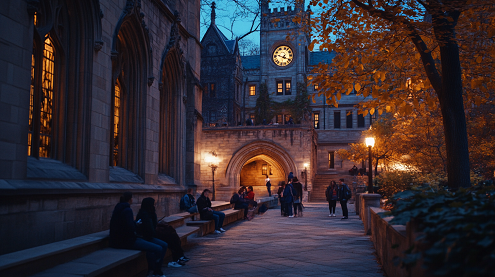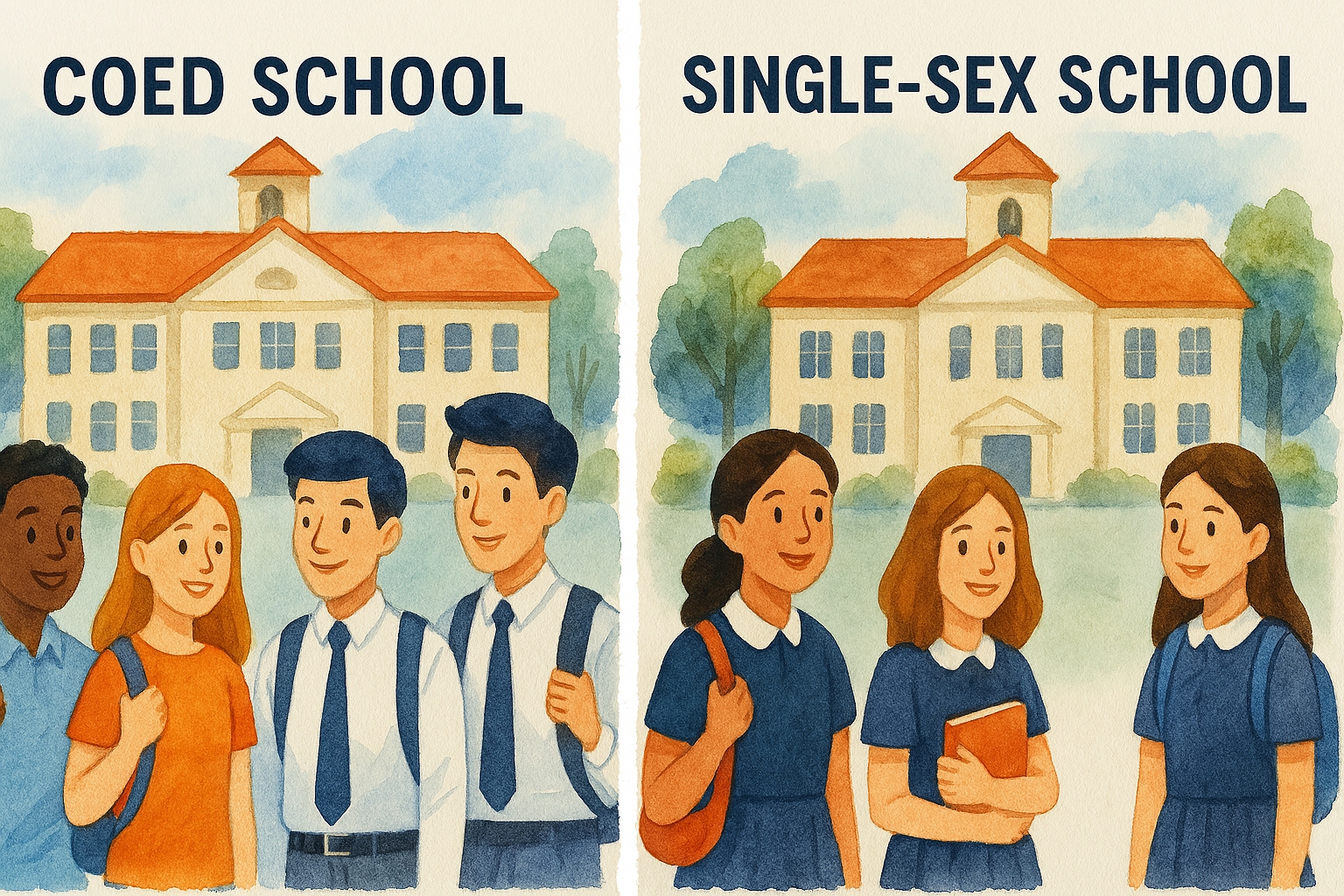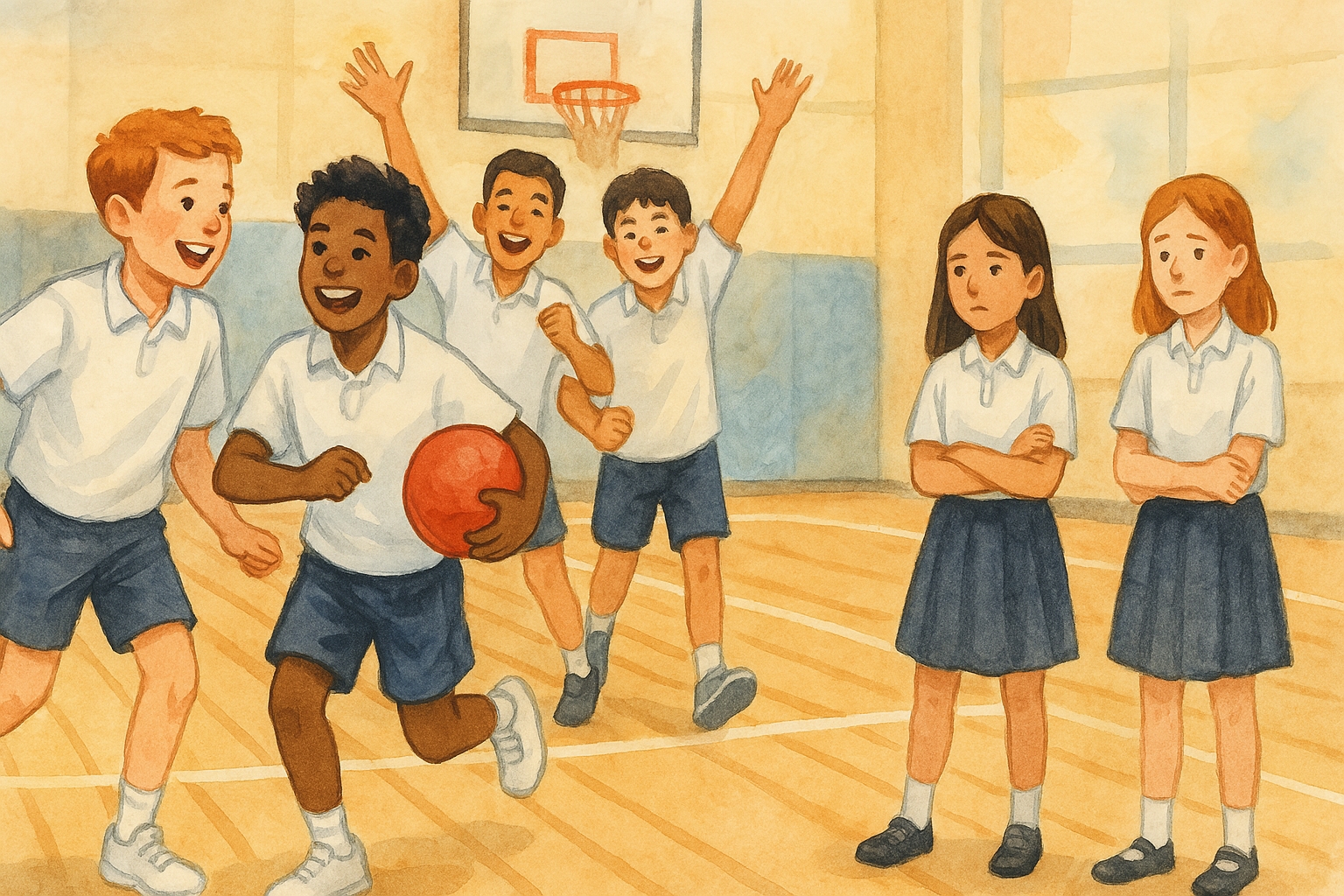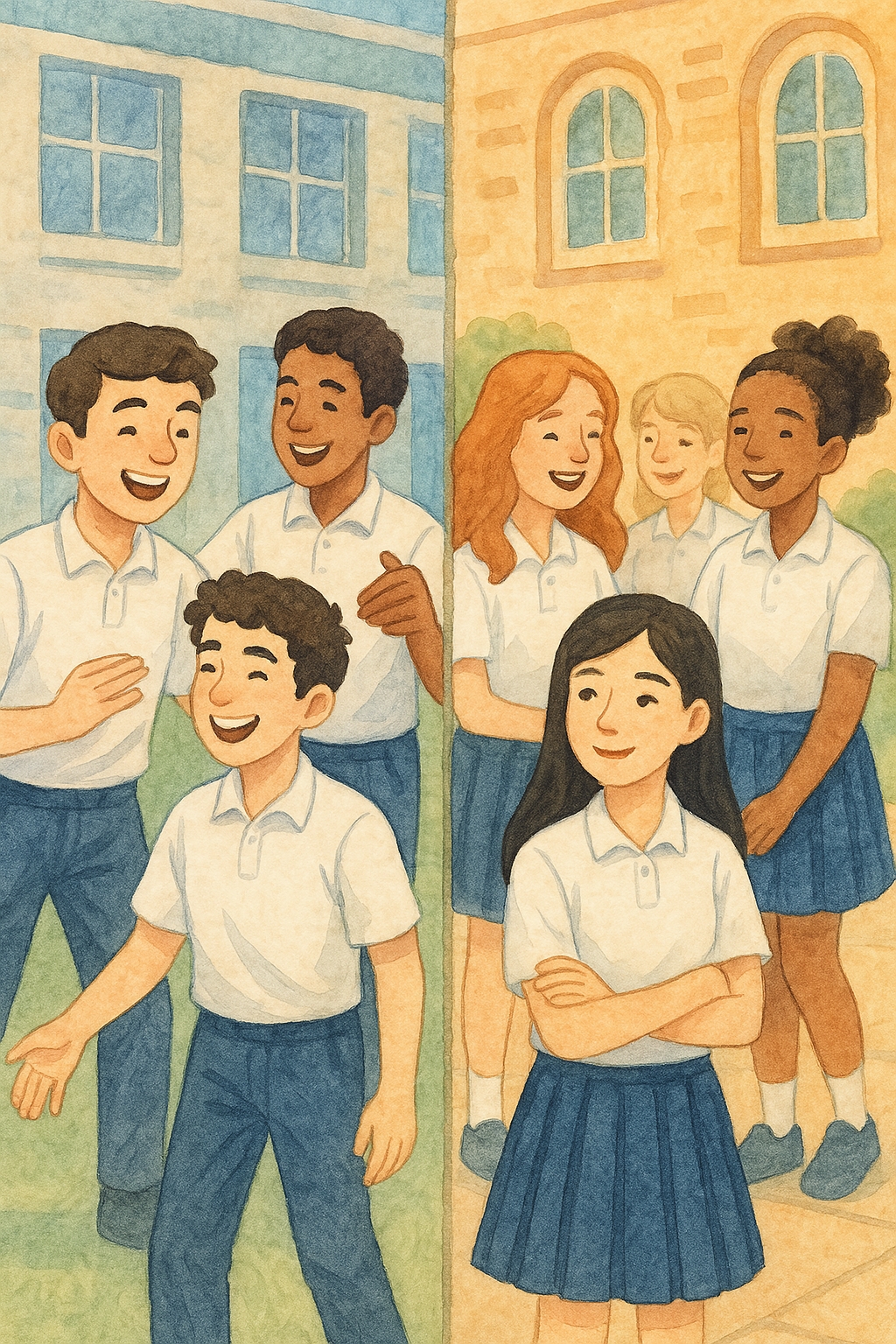Co-ed vs. Single-Sex Boarding Schools: Pros and Cons

Boarding schools aren’t all built the same. Some mix boys and girls together for a real-world feel, while others keep things single-gender to help students focus and feel more at ease. The choice often comes down to what a school believes works best — and what feels right for your child. If you’re stuck between “what’s best” and “will they be happy,” don’t worry. We’re here to break down the pros and cons so you can skip the guesswork and find the fit that really clicks.

What’s the Difference Between Coeducational and Single-Sex Schools?
The basics are simple. Coeducational schools bring all genders together. Students share classrooms, participate in the same clubs, and live on the same campus, often in separate dorms.
Single-sex schools enroll only one gender. These schools design their academics, activities, and community life around a single-gender experience. Each approach creates a different learning environment. And both have their strengths, depending on the student and the goals you’re looking for in a school.
What are the Pros and Cons of Coeducational Boarding Schools?
Co-ed boarding schools are built to mirror the world outside of school. Students learn to work with and understand people of all genders in everyday settings, from group projects to student council elections. It’s a setup that many believe offers a solid head start on college life, future workplaces, and pretty much anything that involves being a human in the world.
| Pros | Cons |
| Balanced Social Learning | Potential for Social Distractions |
| Broader Class Discussions | Uneven Participation |
| Wider Range of Clubs and Activities | |
| Prepares Students for the Real World |
Pros of Coeducational Boarding Schools
Balanced Social Learning

Co-ed schools are a daily crash course in teamwork, empathy, and knowing when to stop talking and actually listen. Whether students are paired up for a lab experiment or co-captaining the debate team, they’re constantly learning how to collaborate with all kinds of people. That means fewer awkward stumbles later on when they’re thrown into a college group project or a summer job with real-life coworkers.
Broader Class Discussions
Mixed-gender classrooms have a way of sparking richer conversations. A discussion on To Kill a Mockingbird might bring out one student’s focus on justice, while another homes in on childhood and identity. The result? A more colorful, engaging back-and-forth that helps students stretch their thinking. When different voices are at the table, class feels less like a monologue and more like a true exchange of ideas.
Wider Range of Clubs and Activities
In co-ed schools, clubs often reflect a wider mix of interests. You’re more likely to see things like a student-run podcast that reviews both sports highlights and fashion trends, or a coding club that partners with the art department to build interactive installations. With so many personalities in the mix, students are exposed to new hobbies, creative ideas, and sometimes, things they never imagined they’d love. (Yes, even Model UN.)
Prepares Students for the Real World
From the classroom to the dorm common room, co-ed schools help students get comfortable navigating real-world dynamics. They practice giving feedback, asking questions, and speaking up in mixed settings, all before graduation. So when they walk into a college seminar or a team meeting at their first job, they already know how to hold their own. The goal isn’t just good grades — it’s the confidence to join any conversation in anywhere and to anyone.
Cons of Coeducational Boarding Schools
Potential for Social Distractions
Let’s be honest. Teenagers have a lot going on, and academics aren’t always at the top of the list. In co-ed schools, social distractions can creep in fast. Think hallway crushes, breakups during finals week, or group projects that turn into emotional group chats. A student might walk into biology class ready to learn about cell division, only to spend the entire period wondering if someone liked their latest post. These moments are natural, but they can make it harder to stay focused — especially when everyone is learning how to balance friendship, romance, and responsibility at the same time.
Uneven Participation
Despite everyone sitting in the same classroom, not everyone always feels equally comfortable raising their hand. In a co-ed physics class, boys might dominate the board work while girls hesitate to speak up, even when they know the answer. In English class, girls might steer the conversation while some boys check out entirely. These patterns aren’t universal, but they show up often enough to matter. Gender dynamics, whether subtle or obvious, can shape how students participate and how they view their own potential — especially in subjects where outdated stereotypes still linger.

What are the Pros and Cons of Single-Sex Boarding Schools?
Single-sex boarding schools focus on creating a space where students can grow without some of the social pressures that may come with a mixed environment. Many of these schools aim to challenge stereotypes and support student confidence, particularly in traditionally underrepresented subjects.
| Pros | Cons |
| Fewer Classroom Distractions | Limited Interaction With Other Genders |
| Curriculum Tailored to Gender-Specific Needs | Possibility of Reinforcing Gender Norms |
| Boost in Confidence | Less Diversity in Perspectives |
| Strong Peer Communities | Not One-Size-Fits-All |
Pros of Single-Sex Boarding Schools

Fewer Classroom Distractions
Take away the daily guessing game of who’s crushing on who, and you get a classroom with a little less drama and a lot more focus. In single-sex schools, students can zero in on the lesson instead of trying to decode side glances or lunch table politics. A ninth-grade girl might actually be thinking about her chemistry lab instead of whether her lab partner noticed her new haircut. Social lives still exist, of course, but the academic side gets a clearer shot at the spotlight.
Curriculum Tailored to Gender-Specific Needs
One perk of a single-gender setting? Teachers can get creative about how they teach. That might mean more hands-on projects, active learning, or collaborative assignments that play to how their students naturally engage. A boys’ school might dive into an engineering course where building rockets is just part of the week. Meanwhile, a girls’ school might introduce programming through design projects that blend storytelling and tech. It’s not about limiting learning — it’s about making sure the material lands.
Boost in Confidence
Without the pressure of impressing or being judged by the opposite gender, students often find it easier to speak up and take the lead. That girl who loves math? She might feel totally comfortable walking up to the board and tackling a problem in front of the class. And that boy who writes poetry? He might finally feel bold enough to share his work out loud. When students aren’t worried about how they’ll come across, they’re more willing to stretch, stumble, and grow.
Strong Peer Communities
There’s something special about growing up in a space where everyone’s figuring out similar things at the same time. In single-sex schools, students often form friendships that feel more like family. Picture a dorm full of girls cheering each other on through college apps, or a group of boys quizzing each other on bio vocab after soccer practice. These bonds tend to run deep and last long — the kind of friendships that survive graduations, relocations, and maybe even group chats.
Standout Single-Sex Boarding Schools That Have Unique Programs
All-Girls Boarding Schools
Emma Willard School (Troy, NY)
Program Highlight: The Signature program at Emma Willard School is a capstone experience for juniors and seniors. It allows students to delve into self-directed projects aligned with their personal interests, often encompassing areas like social justice, innovation, and leadership. Students collaborate with a Signature manager to set and achieve their goals, engaging in projects that have included biotechnology research, journalism, and activism.
Why It’s Unique: The all-girls environment at Emma Willard fosters an atmosphere where students can confidently pursue ambitious projects. This setting encourages fearless intellectual exploration and leadership development, empowering young women to make meaningful contributions in their chosen fields.
Miss Porter’s School (Farmington, CT)
Program Highlight: Miss Porter’s School offers a suite of leadership programs through its Porter’s Center for Global Leadership (PCGL). Notably:
- Porter’s LEADS: A series of workshops designed for middle school girls (grades 5–8), focusing on building leadership skills and addressing global issues.
- Summer in Farmington: A residential summer program for girls in grades 6–9, offering various institutes such as the Sarah Porter Leadership Institute, which emphasizes principles of leadership, risk-taking, and resilience.
Why It’s Unique: These programs are tailored to empower girls by providing them with the tools and experiences necessary to develop confidence, public speaking abilities, and global leadership skills. The all-girls setting ensures a supportive environment where participants can explore their potential without the social pressures that might be present in coeducational settings.
All-Boys Boarding Schools
Avon Old Farms School (Avon, CT)
Unique Program: The Avon Experience
- This includes a blend of challenging academics, athletics, community service, and a strong mentorship program.
- The Brotherhood model promotes leadership, accountability, and integrity among peers — ideals that are intentionally cultivated in an all-male setting.
- Emphasis on structured routines, physical activity, and hands-on learning, aligning with how boys often learn best.
Why It’s Unique: The single-sex environment allows for focused emotional development and leadership training without the added social pressures of co-ed dynamics. The mentorship culture is deeply ingrained, encouraging boys to support one another academically, socially, and personally.
Woodhall School (Bethlehem, CT)
Unique Program: Individualized Instruction & Experiential Learning
- Woodhall is known for serving bright boys with learning differences through highly personalized, one-on-one education plans.
- Offers a Communication Skills Program that helps students develop public speaking, interpersonal, and expressive language skills in a safe, supportive environment.
- Features a non-competitive athletics program that prioritizes personal growth and team-building over performance metrics.
Why It’s Unique: The all-boys setting supports confidence-building and academic risk-taking, especially for students who have struggled in traditional co-ed environments. The school’s size and mission allow it to fully cater to boys’ educational and developmental needs in a highly individualized way.
Cons of Single-Sex Boarding Schools
Limited Interaction With Other Genders
When students spend most of their school years in a single-gender environment, they may have fewer chances to develop the interpersonal skills that come from working with peers of different genders. Picture a student who’s confident in class discussions and group work — as long as the group looks a lot like them. Once they step onto a college campus or into a mixed team at work, that lack of experience can feel like a steep learning curve. Navigating different perspectives, communication styles, and group dynamics is a life skill, and it takes practice.
Possibility of Reinforcing Gender Norms
Single-sex schools can sometimes lean into traditional roles without meaning to. An all-girls school might unintentionally put more focus on the humanities, while an all-boys school might emphasize sports and STEM. While these aren’t problems on their own, students may feel boxed in if certain interests or strengths aren’t nurtured equally. For example, a boy who wants to pursue dance or creative writing might feel like the odd one out if those programs are underdeveloped. The best single-sex schools work hard to break stereotypes, but it’s still something to watch for.
Less Diversity in Perspectives
With only one gender in the room, the conversation can feel a little one-note. Classroom debates and project brainstorms may lack the variety of viewpoints that co-ed settings naturally bring. In a literature discussion, students might miss out on how a character’s experience resonates differently across gender lines. In a history project, certain angles might go unexplored. It’s not that the conversations aren’t valuable — they just might not stretch as far without a broader mix of experiences and opinions in the room.
Not One-Size-Fits-All
Some students thrive in single-sex schools. They find their voice, build confidence, and lean into leadership. Others? Not so much. For some kids, the environment may feel a little too narrow or a bit out of sync with how they like to learn and socialize. A student who craves balance, variety, or just wants to avoid the feeling of being “surrounded by sameness” might feel stifled. Choosing a school is personal, and even the best single-sex program won’t be the right fit for every student.
Need Help? Cardinal Education Can Lend a Hand!
Boarding schools are notorious for their competitive admissions. That’s why we always strive to help students and their families the best way we can. Here at Cardinal Education, we offer help by giving you the necessary skills to succeed in your academic journey. Apart from academic coaching and test prep, we also have dedicated SSAT Practice Tests and ISEE Practice Tests. We ensure students are in their best shape to tackle any tasks! Contact us today and let our experts guide you!
Like what you see here? We are happy to permit you to use our material as long as you link back! Please refer to us as the Cardinal Education Blog.
Related Articles:
How to Ace Boarding School Admissions: Tips to Stand Out and Get Accepted
Boarding School vs. Day School: What’s the Right Fit in 2025?
Frequently Asked Questions
- What are the best all-girls boarding schools in the U.S.?
When it comes to all-girls schools that shine, a few names always rise to the top. The Brearley School in New York is legendary for its academic intensity and Ivy League pipeline. Castilleja School in Palo Alto blends rigorous learning with serious leadership training. The Winsor School in Boston offers both brains and balance, encouraging students to think big and speak up. These schools create environments where girls lift each other up, take charge, and explore every possible path — from coding to classics. If you’re looking for a place where young women thrive, lead, and leave ready to take on the world, these are great bets.
- What are the best all-boys boarding schools in the country?
All-boys schools offer more than dress codes and school crests. Phillips Exeter Academy in New Hampshire is famous for its round-table Harkness discussions and sky-high academic standards. St. Albans School in D.C. blends tradition with heart, building not just scholars but strong character too. The Roxbury Latin School in Boston? Small, mighty, and consistently ranked at the top. These schools know how to shape young men who are thinkers, leaders, and teammates all in one. Whether your son’s a math whiz, a soccer star, or a future playwright, these campuses offer the challenge and community he needs to grow with confidence and purpose.
- How does gender affect learning?
Gender doesn’t dictate how kids learn, but it can nudge things in certain directions. Studies suggest boys might prefer movement and hands-on work, while girls may lean into language and collaboration a bit earlier. But it’s not a fixed formula. One girl might love physics more than poetry, and one boy might outtalk the whole class. What’s more important is how schools respond. The best classrooms create space for every student to explore, speak up, and stumble a little without fear. So while gender can shape classroom habits, great teaching keeps the door wide open for all kinds of learners to shine.
- Which is easier to get into: single-sex schools or coed boarding schools?
This isn’t a one-size-fits-all answer. Some single-sex schools are tiny and selective, which means fewer seats and more pressure. Others may have smaller applicant pools, which sounds promising until you realize their standards are sky-high. Coed schools usually get more applications, especially the big-name ones, so it can feel like a crowded race. But here’s the thing: admissions isn’t just about numbers. It’s about fit. Schools want to know if your child belongs in their community and will thrive there. So instead of asking which is easier, try asking which is right. The better the match, the better the odds.



